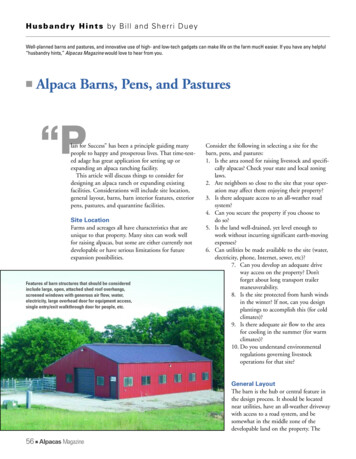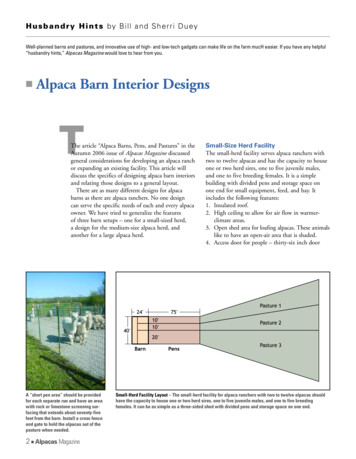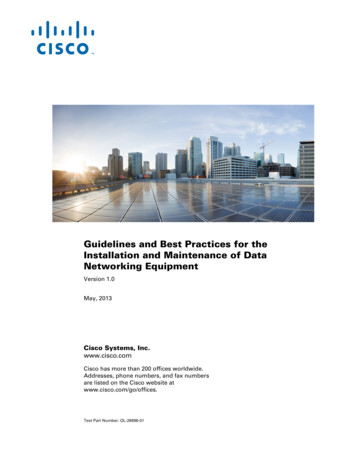
Transcription
H u s b a n d r y H i n t s by Bill and Sherri DueyWell-planned barns and pastures, and innovative use of high- and low-tech gadgets can make life on the farm mucH easier. If you have any helpful“husbandry hints,” Alpacas Magazine would love to hear from you. Alpaca Barns, Pens, and Pastures“Plan for Success” has been a principle guiding manypeople to happy and prosperous lives. That time-tested adage has great application for setting up orexpanding an alpaca ranching facility.This article will discuss things to consider fordesigning an alpaca ranch or expanding existingfacilities. Considerations will include site location,general layout, barns, barn interior features, exteriorpens, pastures, and quarantine facilities.Site LocationFarms and acreages all have characteristics that areunique to that property. Many sites can work wellfor raising alpacas, but some are either currently notdevelopable or have serious limitations for futureexpansion possibilities.Features of barn structures that should be consideredinclude large, open, attached shed roof overhangs,screened windows with generous air flow, water,electricity, large overhead door for equipment access,single entry/exit walkthrough door for people, etc.Consider the following in selecting a site for thebarn, pens, and pastures:1. Is the area zoned for raising livestock and specifically alpacas? Check your state and local zoninglaws.2. Are neighbors so close to the site that your operation may affect them enjoying their property?3. Is there adequate access to an all-weather roadsystem?4. Can you secure the property if you choose todo so?5. Is the land well-drained, yet level enough towork without incurring significant earth-movingexpenses?6. Can utilities be made available to the site (water,electricity, phone, Internet, sewer, etc)?7. Can you develop an adequate driveway access on the property? Don’tforget about long transport trailermaneuverability.8. Is the site protected from harsh windsin the winter? If not, can you designplantings to accomplish this (for coldclimates)?9. Is there adequate air flow to the areafor cooling in the summer (for warmclimates)?10. Do you understand environmentalregulations governing livestockoperations for that site?General LayoutThe barn is the hub or central feature inthe design process. It should be locatednear utilities, have an all-weather drivewaywith access to a road system, and besomewhat in the middle zone of thedevelopable land on the property. The56 Alpacas Magazine
It is important to have the capability to hold alpacas in separate groupsinside the barn. Interior stalls can be made of wood or steel pipe panelsor wood board fences. Numerous walkthrough gates are required for easein handling alpacas.barn should be situated to allow penand pasture layout on three sides.Design the general layout – barn,pens, and pastures to maximize futureexpansion possibilities. Starting out,you can build pens and pastures off ofjust one side of the barn. Later on, youcan expand your operation and placepens and pastures off the second andthird sides of the barn if you desire.The Barn – “Grand CentralStation”A barn serves many purposes for alpacaranchers. A well-designed barn providesthe alpacas a place to seek protectionfrom precipitation, the sun, and harshwinter winds (in some climates).Barns also provide alpaca rancherswith a place to: store equipment usedin working with alpacas, store feed forthe alpacas, and an area for handlingthe alpacas out of the weather. A welldesigned barn will give the alpacarancher the option of handling alpacasinside to administer monthly shots,trim toenails, feed, breed alpacas, shearand handle fiber, train alpacas forshows and leading, and conduct veterinarian procedures such as blood drawsand ultrasounds, etc.Features of barn structures that shouldbe considered are:The alpaca chute and scales should be incorporated into the interior barnpen design. The interior panel configuration should facilitate a systematicmovement of alpacas from all pens to the chute.1. Large, open, attached shed roofoverhangs (at least 18 feet of overhang out from the barn, especiallyin cold climates, so snow doesn’taccumulate near the access point tothe barn)2. Well-ventilated barn interior (lots ofwindows and doors for generous airflow)3. Insulated roof (keeps the barn coolerin summer)4. Water service to the barn5. Electrical service inside the barn6. Large overhead door(s) for equipment access7. Numerous walkthrough doors foralpaca access to pens8. Single entry/exit walkthrough doorfor people (better security)9. Exterior walls that are also finishedon the inside of the barn10. Sidewalls – minimum of ten feet inheight11. Overhang roof clearance – minimum of seven feet12. Adequate roof (or attic) ventingBarn Interior FeaturesThe floor plan for the barn interiorshould include consideration for thefollowing areas: interior pens, feed storage, equipment storage, fleece shearing/handling, climate controlled stall,and a chute.It is important to have the capabilityto hold alpacas in separate groupsinside the barn. To do this, interiorstalls are used and coincide with penconfigurations on the outside of thebarn. Interior stalls can be made ofsteel pipe panels or wooden boardfences. Both need to be firmly supported with posts or designed to be selfsupporting. Numerous walkthroughgates are required for ease in handlingalpacas. One series of panels should beconfigured to operate in harmony withthe alpaca chute located in the barn.The panel configuration should facilitate a systematic movement of alpacasfrom all pens to the chute.Feed storage includes both hay andcommercially prepared bagged feed.Bagged feed needs to be keep clean,dry, reasonably cool and away fromrodents. This can be as simple asstoring several bags of feed in metalgarbage cans or as elaborate as buildinga separate feed storage room.Hay must be stored out of theweather in order to keep it in primecondition for feeding to alpacas. Haystorage does take considerable space.If you purchase hay all at one time orharvest your own hay, you need to havea large area for storing the haythroughout the year. Some ranchershave their main hay storage site awayAutumn 2006 57
Husbandry HintsAlpacas like to be outside. The barn shed roof or overhangarea is a preferred hangout for alpacas, especially if theirwater and feed are available in that zone.It is helpful to have the ability to occasionally confine the alpacas outside the barn, but up under theshed roof. Other times, it is helpful to be able toconfine alpacas to a larger pen extending from theoverhang, but holding them out of the pasture.58 Alpacas Magazinefrom the alpaca barn. Othersmake several carefully-timedpurchases and deliveries of haythroughout the year. With thesemethods, the amount of haystored in the alpaca barn is onlythat which is needed to get byuntil the next delivery (plus afew weeks’ supply in case ofinclement weather). Otheralpaca ranchers store all of thehay needed throughout the yearin their alpaca barn. Areas forseveral different types or qualities of hay (grass, alfalfa, etc.)may be needed.An area for equipment storage is most helpful in the barn.Alpaca ranchers accumulatemany different types of specialized equipment and ready accessto that equipment is essential.(See Alpacas Magazine, Summer/2003, “Top Ten Lists of Equipment for Alpaca Owners”)Equipment can include veterinarian kit, neonatal kit, forks,brooms, shovels, halters andlead ropes, wheel barrow,buckets, feed tubs, fans, shears,tooth trimmer, etc. Storageshelves, wall hooks and benchesall need to be incorporated toefficiently store the equipment.The alpaca chute and scalesshould be incorporated into theinterior barn pen design. (SeeAlpacas Magazine, Spring/2004,“Chutes for Alpacas”) Alpacascales can be stored in thealpaca chute, ready for use.One zone of the barn shouldhave an open area that can beused for several purposes: shearing and fleece handling, alpacatraining, alpaca trailer storage,and ranch visitor reception. Forshearing day, a shearing table orfloor mats can be placed in the
Flexibility is very important inmanaging pastures. A series ofgates to provide options fordirecting alpacas from pens tovarious pastures is ideal. Gatesshould be wide enough toallow equipment access formowing, manure management,and maintenance.Pasture runs should becomenarrower as they approach thebarn to allow for easily herdingthe alpacas.middle of the area. After shearingday, the area can be used for haltertraining and handling alpacas in amini-showring setting. The area canalso be used for storing the alpaca trailer when not on the road. When ranchvisitors come to the ranch, this area canserve as the show area for introducingalpacas to visitors.The barn should have a completelyenclosed room that is insulated andcan be heated in cold climates or airconditioned in extremely hot climates.This area is referred to as a climatecontrolled stall. (See Alpacas Magazine,Winter/2005, “Climate ControlledAlpaca Stalls”)Barn floor materials in the alpaca penareas can be lime screenings, rock chipsor rubber horse stall matting. Floormaterials in areas where hay is storedcan be rock, lime screenings, or concrete. For areas where people will beworking or equipment is stored rockchips, rubber stall mats or concretework very well.Outside Pens for ConfiningAlpacasAlpacas like to be outside. The barnshed roof or overhang area is a verypopular hangout for alpacas, especiallyif their feed and water are available inthat zone. It is helpful to have theability to occasionally confine thealpacas outside the barn, but up underthe shed roof. Other times, it is helpfulto be able to confine alpacas to a largerpen extending from the overhang, butholding them out of the pasture.Examples of this include confiningalpacas for winter, scheduled veterinarian visits, pasture cleaning, renovation,mowing, etc. These outside pensshould have sturdy posts and panels,large access gates for alpacas and equip-ment, and all-weather surfacing such aschipped rock or lime screenings.This is also a good area to installheated, automatic waterers. The waterers can be protected from precipitation,but are not directly inside the barn.(See Alpacas Magazine, Autumn/2001,“Water Your Alpacas-Automatically”)Alpaca PasturesPastures for alpacas can be of manydifferent sizes, shapes, and grass species.Fencing around the pastures shouldlimit the alpacas to that pasture andexclude all other alpacas and predatorsfrom that pen. (See Alpacas Magazine,Summer/2002, “Alpaca PredatorResistant Fencing”) Flexibility is veryimportant in managing pastures.A series of gates provide options fordirecting alpacas from pens to variouspastures is ideal. Gates should be wideenough to allow equipment for mowing,Autumn 2006 59
Husbandry HintsDesign the general layout to maximize future expansion possibilities. Startingout, you can build pens and pastures off of just one side of the barn. Later, youcan place pens and pastures off the second and third sides of the barn.manure management, and maintenance. Pasture runs shouldbecome narrower as they approach the barn to allow for easilyherding the alpacas.Quarantine FacilityAll alpaca ranchers should develop a plan for including aquarantine facility in their ranch layout. To manage variousdisease risks, a properly-designed quarantine facility that isoperated under a carefully-managed alpaca transportationmanagement plan is becoming increasingly important.An isolated barn and pen setup that is away from the mainalpaca operating facilities can be used to hold alpacas thatare coming to the ranch for breeding or agistment, newlypurchased alpacas, and alpacas that are returning to the ranchafter being bred or shown at alpaca shows.60 Alpacas MagazineSetting up an alpaca ranching facility can be challengingand rewarding. Planning for success can provide you withflexible alternatives when that time comes you decide to takeyour alpaca ranching facilities to the next level. Have funplanning out your ranch.Bill and Sherri Duey operate Southern Iowa Alpacas ranch located in thehills of Southern Iowa 60 miles southeast of Des Moines. They specializein raising Accoyo herd sires. They have incorporated innovative featuresinto their alpaca ranch and conduct seminars on business planning,animal selection, and ranch setup. They also enjoy helping existingranchers learn about new products and techniques for fine-tuning theiroperation. View their site at www.southerniowaalpacas.com or contactthem directly at alpacas@southerniowaalpacas.com.
2. Well-ventilated barn interior (lots of windows and doors for generous air flow) 3. Insulated roof (keeps the barn cooler in summer) 4. Water service to the barn 5. Electrical service inside the barn 6. Large overhead door(s) for equip-ment access 7. Numerous walkthrough doors for alpaca access to pens 8. Single entry/exit walkthrough doorFile Size: 712KB











